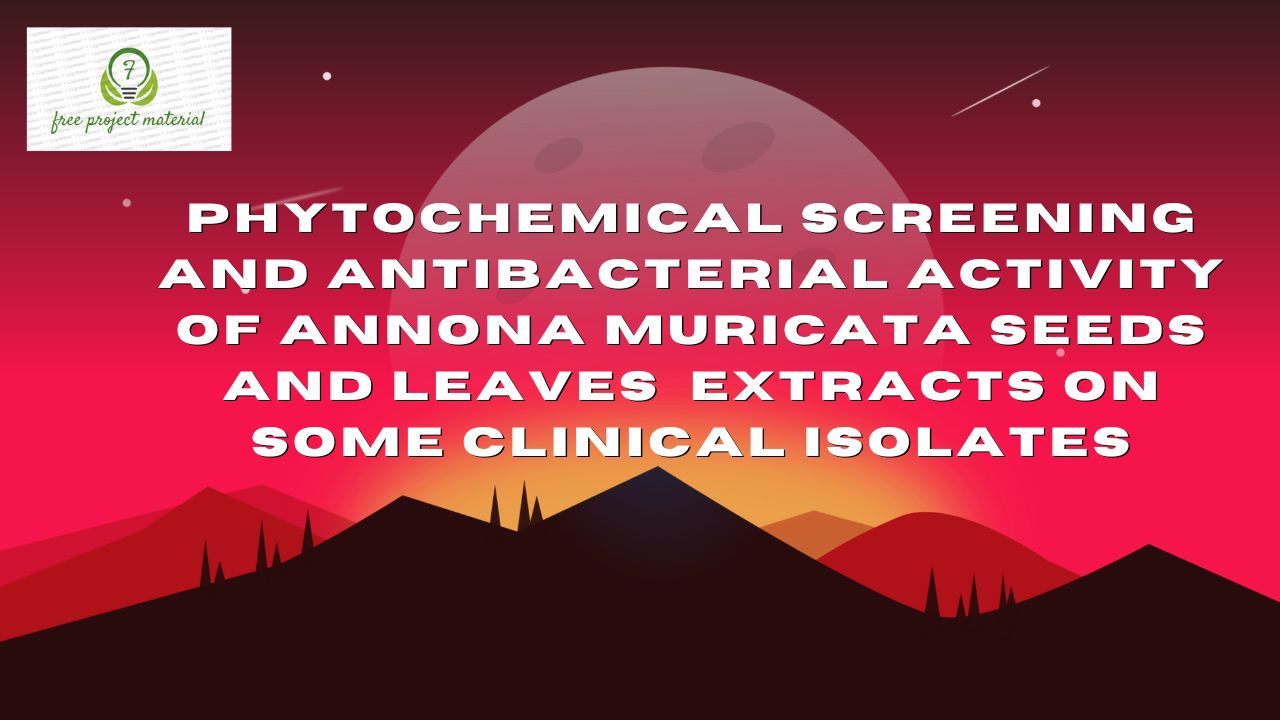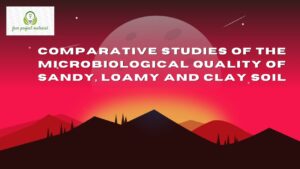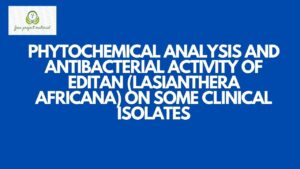ABSTRACT
This study was aim at accessing the phytochemical screening and Antibacterial activity of Annona muricata seeds and leave extract on some clinical isolates. The phytochemical screening composition of the seed and leaves extract. The result of the phytochemical screening of seed revealed that phenol was present in low concentration (+) cardiac glycoside and flavonoid were present in moderate amount (++) and alkaloid and saponins was high, while the leave shows that terpenoid were present in low concentration (+), phenol, cardiac glycoside, flavonoid, alkaloid and saponins was high (++). The antibacterial activity of the ethanol seed of Annona muricata revealed that Campylobacter sp, E. coli and Enterococcus sp was sensitive to 100mg/ml, but resistance to 60mg/ml and 40mg/ml concentration. While the seed aqueous extract revealed that Campylobacter sp, E. coli and Enterococcus sp was sensitive to 100mg/ml, but resistant to 60mg/ml and 40mg/ml concentration. The ethanol leaves extract revealed that Campylobacter sp, E. coli and Enterococcus sp was sensitive to 600mg/ml but resistant to 60mg/ml and 40mg/ml concentration. The aqueous leaves extract show that Campylobacter sp, E. coli and Enterococcus sp was sensitive but resistant to 60mg/ml and 40mg/ml. this result of this study showed that the leaves and seed had activity against the pest organism and could be used for therapeutic purposes and development of drugs.
TABLE OF CONTENTS
Title Page- – – – – – – – – i
Certification- – – – – – – – ii
Dedication- – – – – – – – – iii
Acknowledgements- – – – – – – iv
Abstract- – – – – – – – – v
Table of contents- – – – – – – – vi-viii
CHAPTER ONE: INTRODUCTION
1.1 Background of the Study- – – – – 1-3
1.2 Aim and Objectives of the Study- – – – 3
1.2.1 Objectives of the Study- – – – – – 3-4
1.3 Scope and Limitation of the Study- – – – 4
CHAPTER TWO: LITERATURE REVIEW
2.1 Literature Review of Anona muricata– – – – 5-7
2.2 Botanical Classification and Description
of Annona muricata– – – – – – 7
2.2.1 Botanical Classification of Annona muricata– – 7-8
2.2.2 Description of Annona muricata– – – – 8-9
2.3 Traditional Uses- – – – – – – 9-10
2.4 Medicinal Importance of Annona muricata
(leaf and seed)- – – – – – – 10
2.4.1 Anticancer- – – – – – – – 10-11
2.4.2 Antiulcer- – – – – – – – 11-12
2.4.3 Antidiarrhea- – – – – – – 13
2.4.4 Antidiabetic- – – – – – – 13-15
2.4.5 Antibacterial- – – – – – – 15
2.4.6 Antiviral- – – – – – – – 16
2.5 Antimicrobial Phytochemical in Plants- – – 17
2.5.1 Phenolic- – – – – – – – 17-18
2.5.2 Quinones- – – – – – – – 18-19
2.5.3 Flavonoids- – – – – – – – 19-20
2.5.4 Tannins- – – – – – – – 21-22
2.5.5 Terpenoids- – – – – – – – 22-23
2.5.6 Alkaloids- – – – – – – – 23-24
2.6 Mechanism of Action of Antibacterial Agent- – 24
2.7 Mechanism of Resistance of Antibacterial Agent- 25-26
CHAPTER THREE: MATERIALS AND METHODS
3.1 Materials- – – – – – – – 27
3.2 Sterilization of Glassware and media- – – – 27
3.3 Methods- – – – – – – – 28
3.3.1 Sample Collection- – – – – – 28
3.3.2 Sample Preparation- – – – – – 28-29
3.3.3 Qualitative Phytochemical Screening
of Annona muricata seeds and leaves- – – 30
3.4 Collection of test Organism- – – – – 30
3.4.1 Purification/Stock of Bacterials Isolates- – – 30-31
3.4.2 Characterization of bacterial isolate- – – – 31
3.5 Preparation of Antimicrobial discs- – – – 31
3.5.1 Disc Diffusion Method- – – – – – 32
3.5.2 Determination of Minimum Inhibitory
Concentration (MIC) by both Dilution Method- – 32-33
CHAPTER FOUR: RESULT AND DISCUSSION
4.1 Results – – – – – – – – 34-43
4.2 Discussion- – – – – – – – 44-46
CHAPTER FIVE: CONCLUSION AND RECOMMENDATION
5.1 Conclusion- – – – – – – – 47
5.1 Recommendation- – – – – – – 47-48
References
Appendix
CHAPTER ONE: INTRODUCTION
1.1 Background of the Study
All over the world, herbal medicine has served as perhaps the most valuable and popular field of traditional medicine. Medicinal plants have been used to treat illnesses since before recorded history (Gajalakshmi, Vijayalakshmi & Rajeswari, 2012). The study of medicinal plants is essential to promoting proper use of herbal medicines and in order to identify potential sources of new drugs (Parekh & Chanda, 2007). According to a World Health Organization (WHO) report, greater than 80% of the world’s population depends on traditional medicine to satisfy their primary health care needs (Vashist & Jindal, 2012). Finding new naturally active compounds of plants and plant-based products has interested many scientific researchers. In this regard, the antimicrobial properties of botanicals have attracted a great deal of attention as a promising potential source of novel pharmaceutical drugs.
Soursop is one of the medicinal plants reported to have properties beneficial to health. Its scientific name is Annona muricata (Sarah, Mustafa & Rehab, 2015). Annona muricata, commonly known as graviola or soursop, belongs to the family of Annonaceae. It is a typical tropical tree, with heart-shaped edible fruits and widely distributed in most tropical countries (Foong & Hamid, 2012). It is a small tree, native to and widespread in Central America and the Caribbean, but now also widely cultivated, and in some areas becoming invasive, in tropical locales throughout the world (Le Ven et al., 2011; Moghadamtousi et al., 2015). It has become an important crop because of its tasty flavor, high pulp content, nutritional value, and antioxidant properties (Moghadamtousi et al., 2015).
Gajalakshimi et al., (2012) reports that A. muricata is a traditional medicinal plant with phytochemical constituents and bioactive compounds possessing diverse medicinal properties. Intensive chemical investigation of the leaves and seeds of the species have resulted in the isolation of a great number of acetogenins (Moghadamtousi et al., 2015). The isolated compounds display some desired biological and pharmacological effects such as anti-tumoral properties, cytoxicity, and pesticidal properties (Moghadamtousi et al., 2015).
Soursop leaves contain flavonoids, tannins, alkaloids, saponins, calcium, phosphorus, carbohydrates, vitamins A, B, and C, phytosterol, and calcium oxalate (Edeoga et al., 2005). The leaves are traditionally used to prevent and treat asthma, bronchitis, biliary disorder, diabetes, heart diseases, rheumatism, tumors and cancer (Wicaksome et al., 2011). The plant has also been reported to exhibit anti-inflammatory and analgesic effects (Mustafa and Rehab, 2015).
1.2 Aim and Objectives of the Study
The aim of the study is study the photochemical and access the antimicrobial activity of the leaves and seed extract of soursop on some enteric bacterial.
- Objectives of the Study
- To assess the phytochemical constituent of the leaves and seed extract of Annona muricata
- To assess the antibacterial effect of the leaves and seeds extract of Annona muricata on some enteric bacterial
- To determine the MIC (Minimum Inhibitory Concentration) of the leaves and seed extract on the enteric bacteria.
- To make recommendations base on the result of this study.
1.3 Scope and Limitation of the Study
This research work is focused on the Assessment effect of soursop leaves and seed on enteric bacteria and the due to the limited time assigned for this research as well as financial constraint of the researcher, the work was limited to only the leave and seed.


